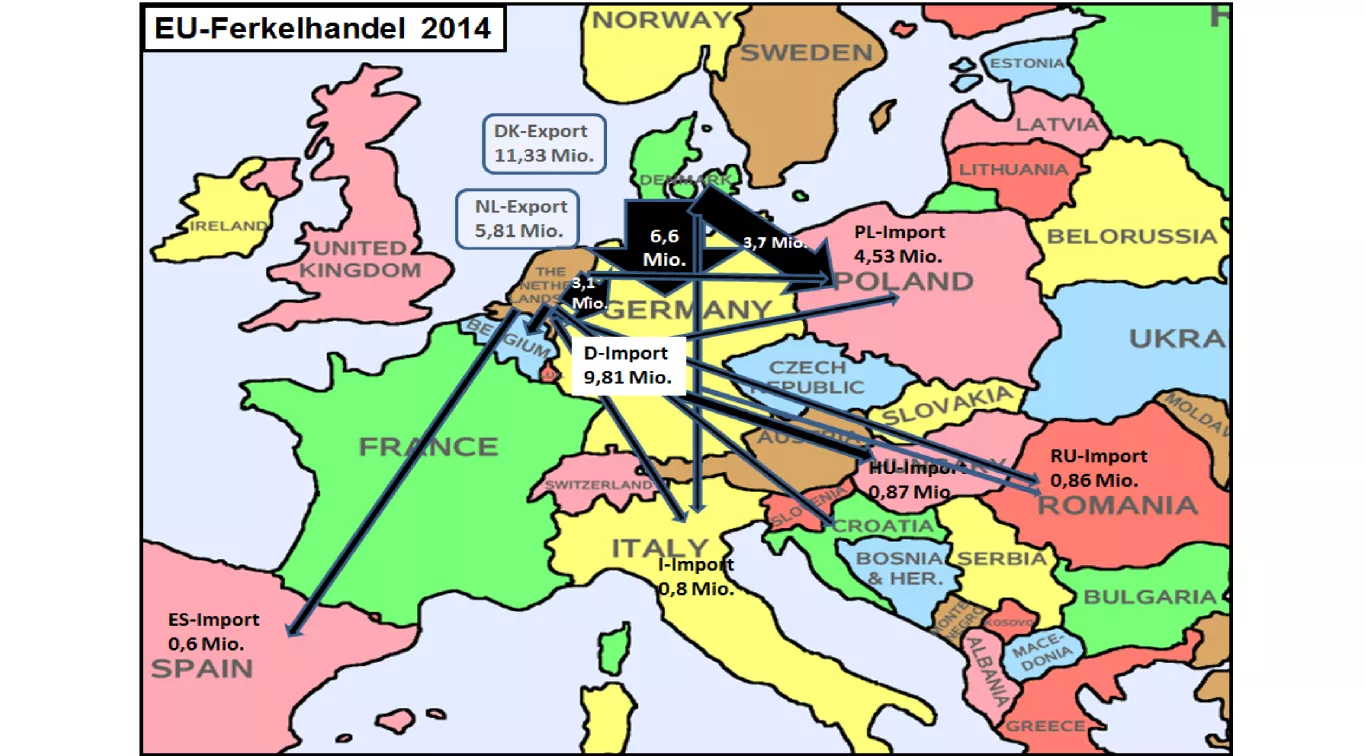RD 20 million piglets are internationally traded in the EU internal market.
An evaluation of piglets trade across borders within the EU single market revealed a recorded total of 20.4 million animals for the year 2014.
On the export side, Denmark with 11.3 million and the Netherlands with 5.8 million are Piglets under 50 kg LG at the top. Approximately 2 million piglets were exported from Germany out. The remaining export volumes were below 0.2 million animals.
The Danish exports go to just under 60% for Germany, but without significant increases in recent years. About one-third of Danish exports now land in Poland. The trend is increasing rapidly, because the Polish sow housing is with their small stocks unable to meet the growing demand for pigs for fattening. Meanwhile Danish pig fatteners in Poland have settled. Danish exports have risen in recent years between 0.5 to 1 million animals per year.
The Dutch pig exports go to more than 50% over the transport near border in the North West German breeding area. The other destinations of Dutch exports are broad, ranging from Belgium (0.6 million) Poland (0.4 million) Romania 0.3 million) Spain 0.47 million to Italy (0.25 million) and Croatia (0.23 million). The volume of Dutch exports stagnated despite net importing country about 4 years piglets are 0.24 million from Germany to Hungary (0.56 million), Poland) and Romania (0.24 million). In the border trade be to Holland (0.24 million) German pig delivered.
On the import side is Germany with an annual quantity of 9.81 million imported piglets at the forefront. Poland has strongly caught up with now 4.5 million animals. While the German imports stagnate for almost 3 years, the Polish imports % annually set to 15 to 20.
Rising import figures are also for Hungary and Romania . Both countries together develop a demand by 1.7 million pigs per year.
Despite the wide distance run Danish piglets to the half of the import volume to Northern Italy . Another portion of Italian imports come from Holland.
The growing piglets trade is expression of different regional conditions. In both export regions NL and DK, the pig pushes to the limits of endurance for years. The piglet production is relatively competitive in the limited production benefits compared to the pig. There are also cheaper attitude structures with increasing benefits through specialization.
In the Central and Eastern European countries , the initial conditions of pigs - in particular the sow housing with small stock structures and low performance - are unfavorable. On the other hand, sufficient space and cheap labor available is for the pig. The environmental requirements are low. The necessary capital is often from foreign lenders.
The German situation is characterized by the concentration on the North West German breeding centre, strongly specialized in cheap piglet supply from neighbouring countries on the pig. But capacity limits are increasingly felt, here so that for the foreseeable future are hardly development opportunities in this space. But still, the benefits of concentration in terms of piglet - and food procurement and sales opportunities from the sales page seem large enough to hold on to the site. The current market Outlook is not likely to open up new less-stressed regions with prospect of success.
On a structural change, you will not over come in future.


